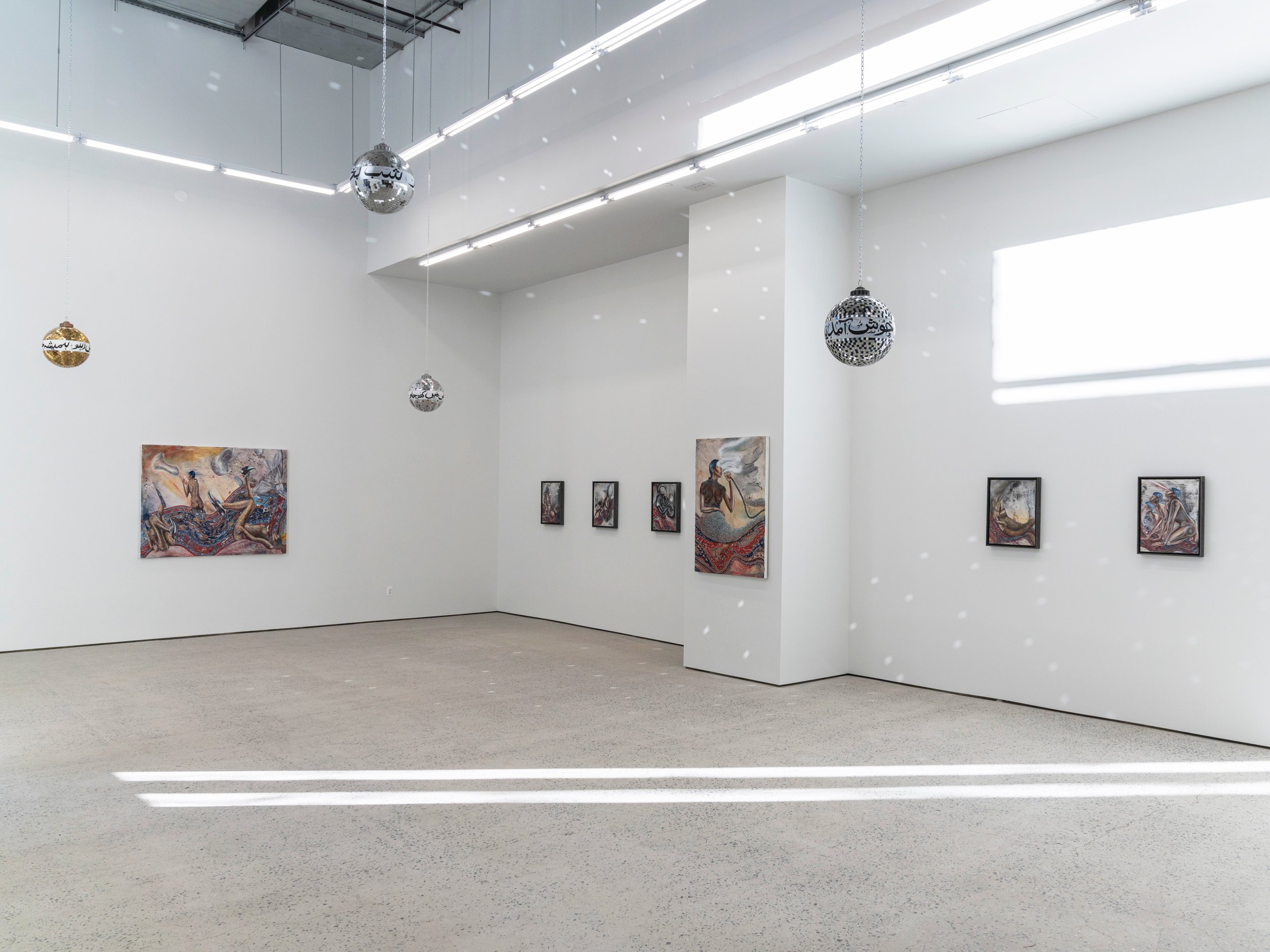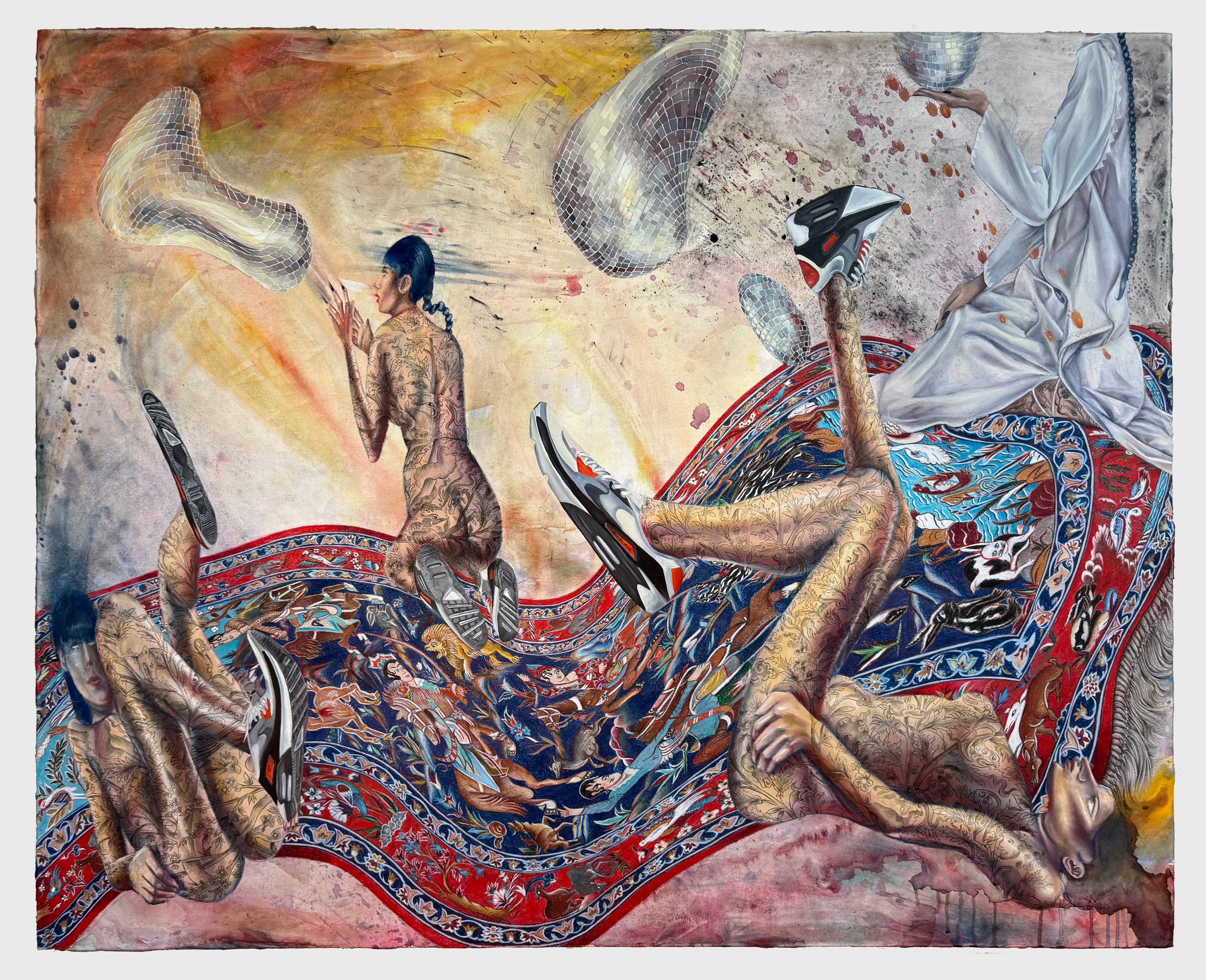Sanié Bokhari
Shaam-e-disco
Swivel Gallery is pleased to present “Shaam-e-disco”, Sanié Bokhari’s first solo exhibition with the gallery featuring a suite of new paintings alongside a kinetic sculpture installation. The figures portrayed by Sanié Bokhari exist in a sort of limbo, a transitional state suspended between time and space, between memories and hallucinations of a faraway place that is still very much a part of her imaginary and cultural language.
November 14th - December 8th 2024
555 Greenwich Street, New York City
Sanié Bokhari, Shaam-e-disco, Installation View, Photo by Cary Whittier
Much of the artist's work is deeply informed by the displacement Bokhari experienced firsthand, growing up in a country like Pakistan, then relocating to the U.S. for her studies at the Rhode Island School of Design. Notably, also the artist's graphic style is still inspired by ancient Pakistani miniature painting, and many of the elements and symbologies she incorporates are derived from books of ancient South Asian and Pakistani myths and folktales. However, for Bokhari, these sources serve as a starting point to transcend cultural boundaries and elevate this heritage to a universal level by tapping into timeless archetypes that are part of a collective unconscious.
Sanié Bokhari (b.1991), Final Fantasy, 2024, Acrylic, Pastel, Graphite and Oil on Canvas, 48 H x 60 W in. / 122 H x 152 W cm.
In her new body of work, Bokhari has ventured into an imaginary universe where feminine figures, enacting as alter egos of the self, allow the artist to explore untamed aspects of femininity, challenging societal norms and embodying independence. Fluctuating in a fluid dimension, this becomes the perfect stage for endless transformations as these figures embody and blend with a series of representations traditionally associated to feminine qualities such as grace, nurturing, mystery, intuition, and of the opposing spectrum, danger and evil.
Mermaids, snakes, spiders and tigers accompany as spirits or become one with the eerie and shadowy female presences as they roam on traditional rugs, the connecting element between the works, suggesting possible transformative journeys through cycles and encouraging growth through both chaos and creation.
At the same time, the luring use of the color palette, primarily based in graphite tones, deep blacks, profound blue and vivid reds, function both as connectors with her homeland scenery and tradition, but also contribute to transport the scene into other dimensions, catalyzing this possible shift from the material world to the spiritual. The process behind the works further contributes to their existence within the duality of mental and mystical spaces: originating as pure abstraction where the artist freely transfers herself and the subconscious through fluid movements of color pigments in their beginnings, followed by Bokhari then molding textures over the surface with a unique use of the pastel ground she concocted. Only as a final step she will then render the figures that will emerge and inhabit that dense nebulous universe.
Sanié Bokhari, Shaam-e-disco, Installation View, Photo by Cary Whittier
A feeling of nostalgia and longing, but also a hope of redemption and regeneration animate the enigmatic compositions, as they convey the concerns of a young woman confronting secular traditions, the pressure of societal and familial expectations, and the need for a spiritual elevation in a detached urban contemporary life. Moving in this porous space, the artist eventually channels a unique perspective of her life and identity in Pakistan and the States today, questioning the oppressing traditions she left behind, but also drawing from the rich ancestral heritage of her roots. In this sense, Bokhari’s works can be read as powerful metaphorical manifestations of a “double consciousness” typical of the diaspora experience: a metaphorization of a deterritorialized critical consciousness, a sort of “ontopology” that deals with the nature of being, but also already enables to transcend cultural specificities.
Ultimately, the powerful feminine spirits imagined by Bokhari can only exist in an a-topia, a no-place between utopia and dystopia, which, extracted from linear time, allows to embrace the universality of multiple consciousnesses and narrations surrounding the multifaceted nature of the feminine archetype, throughout the history of civilization.
Sanié Bokhari (b.1991), Roomshaker, 2024, Acrylic, Pastel and Graphite on Canvas, 48 H x 36 W in. / 122 H x 92 W cm.
Sanié Bokhari (b.1991, Lahore, Pakistan) is a mixed media artist living and working in Brooklyn, NY. She holds a Bachelor’s in Painting from the National College of Arts, Lahore and an MFA in Painting from the Rhode Island School of Design in 2018. She was the recipient of the President’s Scholarship at RISD, and was selected to work with the contemporary art curator at the RISD Museum. She has exhibited her work in numerous shows in Pakistan and the US, including Canvas Gallery in Karachi, Harper’s Gallery in Los Angeles & Aicon Gallery in NYC. Her residencies include the Vermont Studio Center, NARS Foundation, PLOP residency, Vasl Residency, Macedonia Residency and Field Residency. Her work is included in various publications including The OG Magazine, G5A: imprint, Mumbai and Art Seen magazine. Her work has been acquired by notable collections including the Nion McEvoy Foundation, as well as the private collections of Dr. Fadi Braiteh and OJ Prakash, director of Levy Gorvy Hong Kong.






